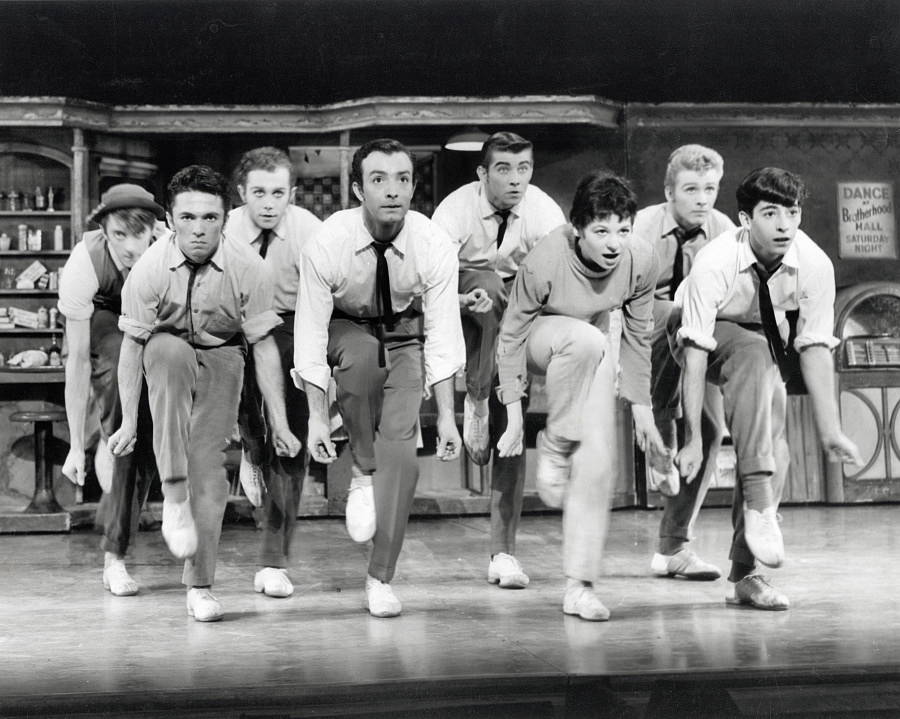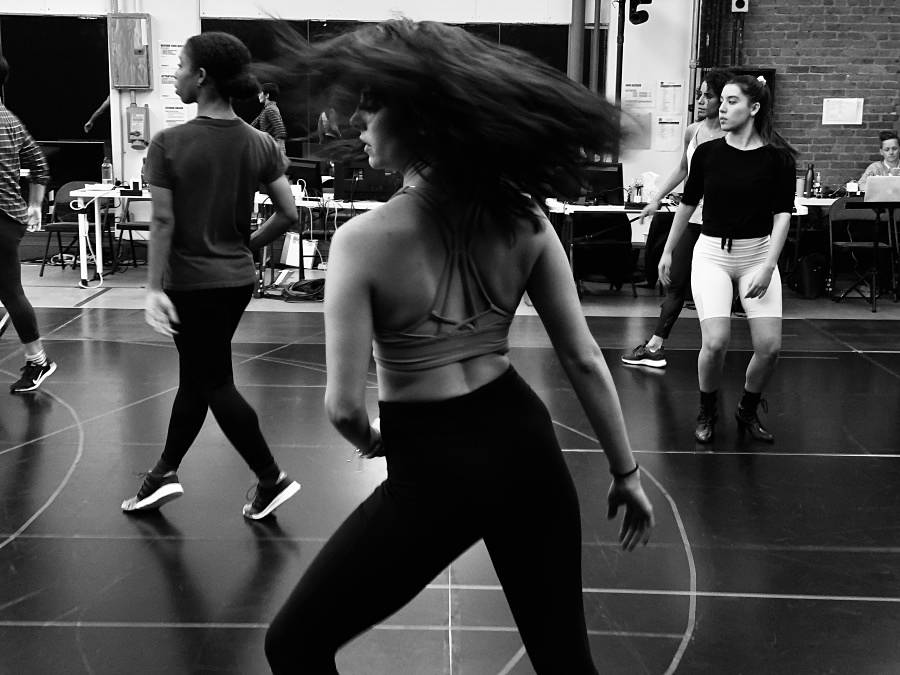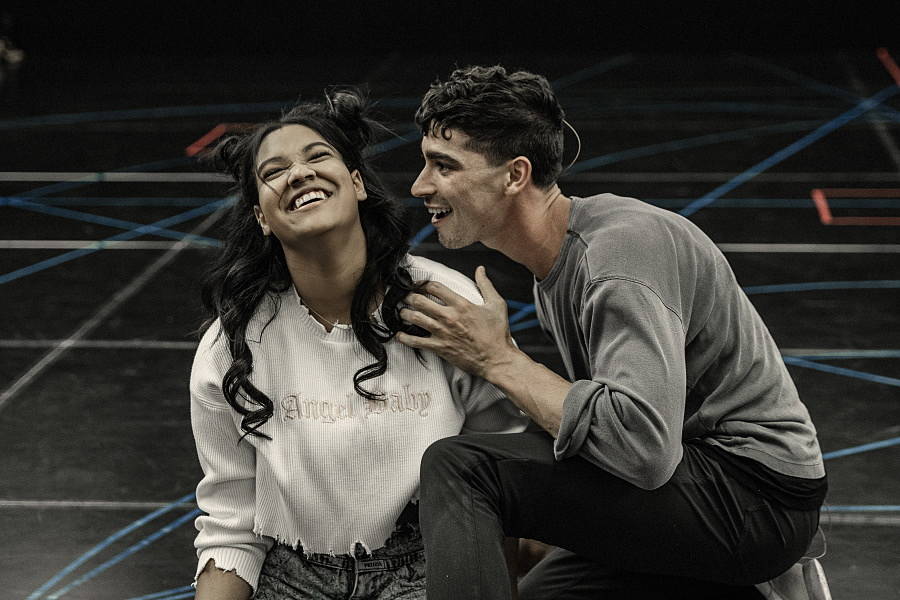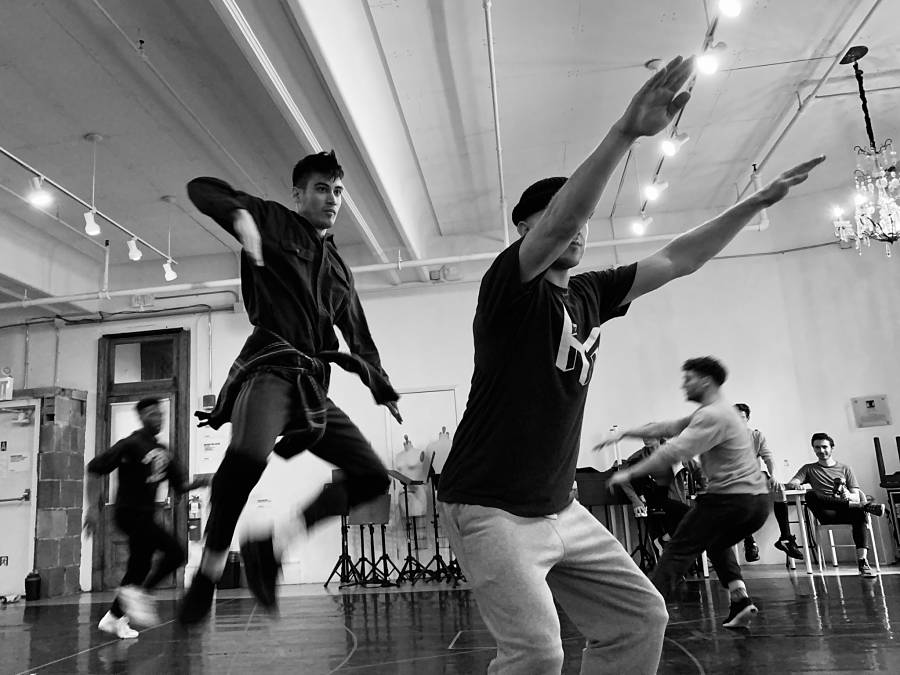Twenty-five years ago, a summer stock theatre in central Pennsylvania hired me to choreograph a production of West Side Story, then promptly fired me when it became clear that I intended to create my own choreography rather than replicate the dance ideas director/choreographer Jerome Robbins conceptualized for the musical’s original 1957 Broadway production and 1961 film. Apparently, to present this seamlessly integrated, revolutionary musical theatre portrayal of teen gang violence without the iconic Robbins choreography was inconceivable.
Imagine my delight upon learning that for the show’s 2020 Broadway revival, its helmsman, experimental Belgian director Ivo van Hove, had insisted on brand-new choreography, made by the brilliant postmodern minimalist Anne Teresa De Keersmaeker, a fellow Belgian. Touted by van Hove as “a West Side Story for the 21st century,” his is the first Broadway staging to forgo Robbins’s choreography. Indeed, though it sticks to the original dialogue and songs (with the exception of a few cuts), van Hove’s startlingly contemporary version is not set in the 1950s. Instead it sets out to illuminate the musical’s timeless themes of ethnic prejudice, violence, and love within a present-day cultural context where the urban youth don’t move like they did on the streets and dance floors of Robbins’s jitterbugging-and-mamboing ’50s America.
Yet just because the characters are moving differently, can this West Side Story really be said to be serving up new choreography? After speaking with van Hove and De Keersmaeker during the show’s rehearsal period and observing an early preview performance (as of press time, the production is slated to open on Feb. 20 at the Broadway Theatre), I tried to answer that question by first asking what constitutes a musical’s “original” choreography. Is it simply the dance steps? Or is it the decisions to have particular characters dance at particular points in the show—as a break within a song, backed by an ensemble, or for an extended sequence that might be termed a “ballet”? Is it the degree to which a show relies on dance to advance the narrative, marking some musicals as “dance shows” and others not? Is choreography defined in terms of its formal elements, the spatial composition it draws upon the stage, or its temporal aspects, the energies generated by the moving bodies?
Musical theatre choreography, in short, encompasses everything the dancing contributes to the drama that the music and spoken word do not. So if De Keersmaeker’s choreography does much of the same work as Robbins did, can we really call it brand new, or is it more properly understood as “updated”?

Typically, revivals of musicals created before the advent of videotape do not incorporate the choreography from the original Broadway production, because they can’t. There’s no record of it, as dance has never been as easily documented as dialogue and music. Visionary choreographer Agnes de Mille made video recordings of herself talking about the dances she created for Oklahoma! and Carousel alongside performance footage of the choreography, but that level of documentation is rare. Ironically, the term “choreography” derives from root words meaning “the writing of dancing in unison.” Yet only a handful of musicals have had their original choreography documented via Labanotation, a detailed language of written symbols representing human body movements in which only a wee percentage of the dance world is literate.
And what about a show like Hair, for which choreographer Julie Arenal asked the original cast members to improvise their own movements, out of which she then built the choreography? When she choreographed later productions of the show, she used the same improvisatory approach. In this sense Hair’s “original” choreography may be nothing more than the concept undergirding its making.
Arthur Laurents, Leonard Bernstein, and Stephen Sondheim’s West Side Story has always been a special case. Inspired by Shakespeare’s Romeo and Juliet—and initially titled East Side Story, as Robbins first conceived it as a conflict between Jews and Catholics on Manhattan’s Lower East Side—the show is not only revered as a shining exemplar of the integrated use of dance in musical theatre. Its signature choreographic elements—finger snaps, charging chassés, sideward kicks that rise up to relevé—have become as widely recognized as any aspect of any American musical.
In fact, Robbins’s choreography has been copyrighted. When an entity obtains permission to perform West Side Story, the rights to the choreography are licensed separately, and they come with a “bible” delineating the exact movements. While the idea of rewriting that bible can feel almost sacrilegious (not to mention actionable), judicious “editing” has been done in productions over the years.
Joey McKneely, choreographer of the show’s 2009 Broadway revival, once explained to me that advancements in dancers’ technique since 1957 necessitated some alteration to retain the original choreography’s emotional impact. Jumps in the “Cool” number, for instance, were originally done in one count, but because McKneely’s dancers had higher elevation than dancers in Robbins’s day, they needed extra time to extend their air position to the extreme point of its line. Also, to maintain the explosive quality of their kicks, McKneely needed to allow his men to kick higher than the original 90 degrees. Because male dancers have greater extension than they did in the ’50s, the all-important explosiveness conveyed by the original choreography would have been lost had they had to restrain their kicks to a 90-degree level.
In these cases, McKneely’s choreography wasn’t considered “new,” even as certain body shapes and rhythms were changed. But the fact that this kind of tweaking of steps is kosher would imply that a show’s choreography is defined less by its specific visual or musical aspects than by its kinetic qualities.

Based on the early preview I saw, viewers of the current revival—especially those who define choreography in terms of steps—are likely to be struck from the get-go by how far De Keersmaeker’s work departs from Robbins’s. While the latter’s rendition opened with a lengthy danced “Prologue,” full of balletic leaping and pantomimic episodes providing exposition about the two street gangs’ increasingly violent rivalry, the opening of the new production the night I saw it was marked by a conspicuous absence of technical dance vocabulary. De Keersmaeker’s Prologue looked succinct and less literal, yet got the job done just as effectively. Masterfully, in a few tension-filled moments during which Jets and Sharks walk, posture, glare, shift their weight, turn, change directions, then pick up the pace, she told all we need to know about how the Sharks, the “new in town” immigrants, are invading turf formerly ruled by the Jets, the American gang who was there first.
Though her work has evolved beyond the minimalist choreography that first garnered her critical notice in the 1980s, De Keersmaeker remains a formalist. Throughout this production, she makes ingenious use of traveling wedge formations, each gang shaped loosely into a triangle with their leader at the point, as they circle, stalk, intimidate, and prepare to pounce. Van Hove says that De Keersmaeker’s facility in moving groups of bodies around a stage is partly why he chose her to choreograph this musical, as it is one in which “groups are really important.”
But the pruned Prologue I saw seemed to signal how much less of a “dance show” this West Side Story is. While most stagings run close to two hours and 45 minutes, including intermission, in previews the revival has been running a full hour shorter than that, sans intermission. To meet this running time, van Hove cut one song (“I Feel Pretty”) and a tiny bit of dialogue, and eliminated significant dance time, including the extended “Somewhere” dream ballet, in which Robbins portrayed an idyllic utopia in which Jets and Sharks live harmoniously. This could be compared to the 2019 Broadway revival of Oklahoma!, which marshaled a minimalist approach in reconceiving that show’s original 1943 choreography. De Mille’s densely populated, narrative-driven dream ballet was radically replaced by choreographer John Heginbotham with an emotionally charged contemporary dance executed by a solo performer. The changes in both these revivals seem to be accommodations to audiences’ dwindling tolerance for drawn-out, choreographic explorations of dramatic themes, in favor of more immediate, symbolic encapsulations of big ideas.
Yet while this WSS is reduced dance-wise, it’s never static, but is instead enlivened by captivatingly choreographed camera movement. Much of the show’s action is seen on a big screen projecting both live and prerecorded video footage that sometimes shows a mysterious dancing figure in the far distance (a Robbins reference, perhaps?). If, historically, the original shifted the balance of elements decidedly toward dance as the primary conveyor of the narrative, here a kind of balance seems to be restored among words, music, dance, and video imagery, an addition sure to resonate with young audiences’ affinity for screen time.
What’s more, the “America” dance—which here includes the Shark men, as in the film version—has changed in a way that should make it more relatable to today’s viewers. Minus the fluffy ’50s-style skirts that the original Shark women swooshed with aggressive seductiveness, the new choreography, while still depicting male-female contention, reflects the more equal terms on which couples now argue. No longer employing saucy sexiness as their weapon, these pants-wearing women prefer to be fierce rather than flirty.
De Keersmaeker’s choreography communicates much of the same dramatic content Robbins’s did, particularly in the “Dance at the Gym,” the scene where Tony and Maria first meet at a raucous social dance. The dancing’s geometric configurations and its movement impulses are largely dictated by the libretto’s stage directions and the score’s journey through specific musical styles, from blues to cha-cha. Here De Keersmaeker appears to be drawing more from Broadway jazz and the showy lifts of Latin ballroom than from the contemporary dance sensibilities informing the kinesthetic world she evokes on the show’s streets for the rest of the musical’s choreography.

What often stood out at the preview I saw was how much movement vocabulary the Jets and Sharks share. This choreographic kinship reflects van Hove’s concept, in which the Jets are not cast as an all-white gang but include Latinx and African American members, while the Sharks comprise a group of diverse-in-color Latinx folks. “Identity is an important part of the tension field between the Jets and the Sharks, yet they have much in common,” De Keersmaeker told me. “They’re both facing poverty and violence, looking for a home, for recognition, for a gang to be their family because they feel excluded.”
In a present-day West Side Story, it seems natural that teen gangs would move with some degree of similarity, as today social media platforms establish dance trends and popularize them globally with astounding immediacy. Incorporating current street-dance styles, hip-hop, and house dancing, De Keersmaeker’s choreography makes meaningful use of floorwork, in direct contrast to Robbins’s balletic loftiness. Where Robbins sent characters jumping straight up into the air or soaring across the space to snare attention and exhibit power, De Keersmaeker is likely to have her Jets and Sharks drop suddenly to the floor level, then dart forward on the side of their hip with a smooth slicing reach of the opposite leg. There’s a feral grace to their floorwork, as they roll and flip over easily and shape their bodies into organic, earthy forms. Our understanding of their connection to their turf deepens as we see how physically in tune they are with the ground.
In a 2018 production at the Guthrie Theater in Minneapolis, which also chose to forgo Robbins’s choreography, choreographer Maija García had the Sharks dance in ways that were more specifically Puerto Rican than in Robbins and co-choreographer Peter Gennaro’s mambo-based, theatricalized Latin choreography, which reflected the Cuban-flavored ballroom dancing that was trendy with many Americans in the ’50s. As with van Hove’s casting, though, De Keersmaeker is less concerned about spotlighting the gangs’ differing ethnicities.
“I think the core of this piece is the relationship between war and love, the tension between an individual and a community,” she says. “There’s too much focus on what differentiates us instead of on what unites us. I would like that to be emerging more than the specifics of each ethnicity, or how Puerto Rican a movement really is.”
While De Keersmaeker’s choreography may seem new in its reflections of contemporary youth culture, what I saw of it could not be called game changing. It doesn’t seem to be aimed at enlarging the role of musical theatre dance in the noteworthy way that Robbins’s work did. Rather, in alignment with today’s technology-obsessed society, it appears to have relinquished the original choreography’s heavy-duty storytelling responsibilities in favor of pithy movement statements that might be seen as choreographic equivalents of tweets. De Keersmaeker’s choreography is never less than striking, and supports this iteration’s directive to speak to 21st-century audiences. If it doesn’t extend our notions of how dance can enrich a musical—a tall order, in any case—it will perhaps best be celebrated not as genuinely novel, but as astutely modernized.
Lisa Jo Sagolla, the author of The Girl Who Fell Down: A Biography of Joan McCracken, is currently working on a book about the influence of Pennsylvania’s Bucks County on U.S. musical theatre.


